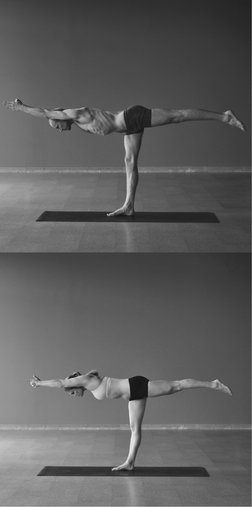|
INTENTION
This posture has two main elements: the standing leg/hip and a straight spine. This is the most demanding strength posture we have for the hips, with the weight of the upper body bent all the way forward and the arms stretched overhead, making the upper body even heavier. The standing hip needs to be very even and very strong in Balancing Stick. Keep the standing leg straight and balanced—don’t hyperextend the knee, roll to the outside of the foot, or let the kicking hip come up. Lengthen the spine as much as possible. Avoid collapsing the chest. Stretch the arms strongly forward. If you are unable to maintain a straight spine with outstretched arms, bring the hands to the hips. This reduces the load on the back and hips. You can also try this modification if you have a weak or injured lower back. BREATH This pose requires a lot of exertion, so the breath will be a little shorter than usual. Keep the breath smooth and relaxed. BENEFITS This posture builds strength in the legs, hips, back and shoulders. It stretches the hamstrings and chest. It builds intense focus, balance and determination. NOTE Focus on not allowing the hip of the lifted leg to tilt upwards. Keep both hips square to the floor. Excerpt from the Ghosh Yoga Practice Manual - Intermediate.
0 Comments
Leave a Reply. |
AUTHORSScott & Ida are Yoga Acharyas (Masters of Yoga). They are scholars as well as practitioners of yogic postures, breath control and meditation. They are the head teachers of Ghosh Yoga.
POPULAR- The 113 Postures of Ghosh Yoga
- Make the Hamstrings Strong, Not Long - Understanding Chair Posture - Lock the Knee History - It Doesn't Matter If Your Head Is On Your Knee - Bow Pose (Dhanurasana) - 5 Reasons To Backbend - Origins of Standing Bow - The Traditional Yoga In Bikram's Class - What About the Women?! - Through Bishnu's Eyes - Why Teaching Is Not a Personal Practice Categories
All
Archives
May 2024
|







 RSS Feed
RSS Feed